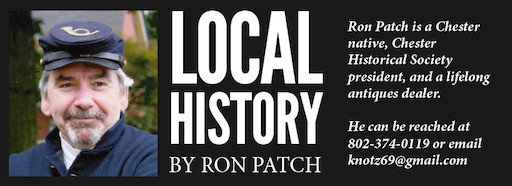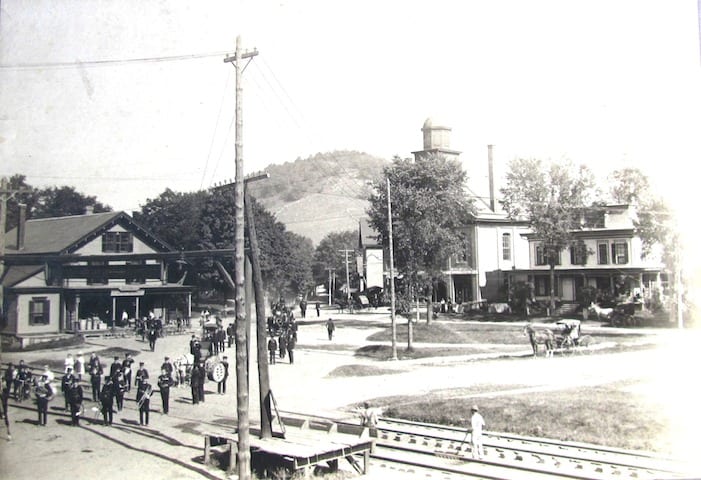
For 150 years Chester Depot has been photographed hundreds of times. At the Chester Historical Society, we have many photos of the Depot taken from different angles and time periods.
Up until the 1950s, the Depot was a beehive of activity. Both freight and passenger trains made daily stops at the Depot.

The photo with this article is in my collection and dates to the 1890s. It’s a very clear and sharp photo. In the background you can see Chester Town Hall. To the right is the Marsh place. Looking down Depot Street next to town hall is the Odd Fellows building. This was torn down maybe 20 years ago and now a parking lot for town employees.
Off to the left is E.J. Davis Hardware store, lastly Cummings Hardware. Under magnification I can see several boys with their bicycles. Off to right on what is Avon Street today a man and woman sit in their buggy.
In the foreground you can see a marching band. Again under magnification I can see painted on the drum, “Saxtons River Cadet Band.” I asked around about this band. No one knew for sure but thought it was part of Vermont Academy.
The railroad tracks can clearly be seen. On the right two railroad workmen dressed in overalls watch as the band passes by. There’s a sign over the street where the band stands. While difficult to see here, it reads, “LOOK OUT FOR THE ENGINE.”
I believe this band was part of a Yosemite Fireman’s parade. If you look up on Flamstead you’ll notice open pasture not wooded as it is today. There is something in this photo not seen in other known photos.
The photo
In other known Depot photos you can see a covered milk platform. Local farmers delivered their milk cans to the platform where they were picked up by the train and delivered to the Bellows Falls Creamery.
Some farmers had metal nameplates on their cans. Others painted their name on the milk cans. When the creamery emptied the milk cans, they were rinsed out and put back on a train to be delivered back to Chester Depot. Here the empty cans were placed on the milk platform to be retrieved by the farmers, refilled and repeated the next day.
In other Depot photos there’s a roof over the milk platform. You’ll notice there is no roof in this photo. This is undoubtedly an earlier milk platform. Most interesting is the utility pole that comes right up through the platform.
The best explanation for this utility pole is that the milk platform was built around the pre-existing pole. This is a telegraph pole, not electric or telephone. The Depot in the late 1860s to early 1870s suffered several disastrous fires. The Depot was often under hurried construction in those early days.
If you look closely at this utility pole you’ll notice it’s shorter than the pole next to it and has a pronounced curve near the top. The photographer took this photo from the upper level of what is Smitty’s today.
Seeing the utility pole coming through the platform reminded me of an auction I attended up in Castleton years ago. The auction was to begin at 10 a.m. Rain was forecast and tents were set up. As the 10 o’clock hour approached rain came down in buckets.
I was standing in a single story addition of the house, kind of a sunroom, with my friend Fitzie, watching the auctioneer scurry around trying to get another tent up. Now I don’t know if you’ve ever seen a tent stake but they are about three feet long and an inch in diameter.
One of the auction runners was on the roof of the addition Fitzie and I were standing in. All of a sudden, thump, thump, thump from the sledgehammer as the runner drove a tent stake through the roof of the addition. We chuckled as the tent stake came through the plaster ceiling above our heads.
Instead of an old saying, and in honor of Labor Day, I offer a Les Allen story. Les ran a service station where Knockout Carpet is today. A woman from out of state pulled in for gas. Les checked her oil and was washing her windshield.
When Les got around to the driver’s side of the windshield, the woman said, “You sure have a lot of funny looking people around here.” Without hesitation, Les replied, “Yes we do, but they all go home after Labor Day.”